 |
|
 |
December 2012 |
 |
|

Call for Presentations is Now Open - Submit an Abstract
|
 |
Feature Article
|
 |
 |
Ultrasonic Metal Welding Foils to Tabs for Li-Ion Battery Cells
The three most common metal to metal joints in an EV battery pack are foil to tab, tab to tab and tab to bus. All three joints pose challenges, but of the three, welding multiple layers of foil to a tab is the most challenging. The joint is often made up of dissimilar metals, the metal thickness is mismatched, and one side (the tab) is relatively thick (e.g., 0.2 mm) while the other is made up of multiple, extremely thin, layers. ...read more
|
|
 |
 |
| |
Sponsored Announcement |
 |
 Cadex Electronics, Inc. is an established global leader in battery management products. With 30 years of experience developing and commercializing technologies for testing and servicing batteries, Cadex has delivered solutions to many of the world’s largest companies in radio and cellular communications, medical devices, portable computing, and aviation. Cadex Electronics, Inc. is an established global leader in battery management products. With 30 years of experience developing and commercializing technologies for testing and servicing batteries, Cadex has delivered solutions to many of the world’s largest companies in radio and cellular communications, medical devices, portable computing, and aviation.
New innovations include the versatile C8000 Advanced Battery Testing System that allows you to optimize batteries at every stage of product life, and the C5100 Battery Testing System that delivers tremendous value to cellular retailers.
Cadex is ISO 9001and ISO13485 (Medical) certified and our products are sold in over 100 countries.
Cadex Electronics Inc.
22000 Fraserwood Way • Richmond, BC V6W1J6 Canada
Contact: Sales • 604-231-7777 • info@cadex.com
www.cadex.com • www.BatteryUniversity.com
Bloggers Wanted - Battery Power is looking for knowledgeable professionals in the Battery industry who’d like to contribute to our online community by writing a blog to be featured on the website and in a monthly eNewsletter. Contributors can submit as often as they choose (1x, weekly, monthly, etc). If interested in more details, contact Shannon Given.
|
 |
 |
| |
New Products |
| |
Microchip Launches 8-bit Microcontrollers with Integrated Configurable Logic in 6- to 20-pin Packages
The PIC10F(LF)32X and PIC1XF(LF)150X MCUs each feature new peripherals, including Configurable Logic Cells (CLCs), Complementary Waveform Generators (CWGs) and Numerically Controlled Oscillators (NCOs), enabling functionality that was not possible before with low pincount MCUs. These general-purpose MCUs enable designers to enhance the functionality, reduce design size, and decrease the cost and power consumption of products.
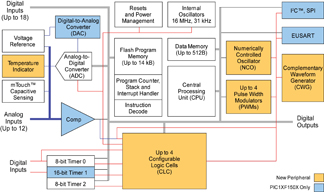 The CLC peripherals on the PIC10F(LF)32X and PIC1XF(LF)150X MCUs enable software control of combinational and sequential logic, which increases the on-chip interconnection of peripherals and I/Os, thereby reducing external components, saving code space and adding functionality. The CWG peripheral works with multiple peripherals to generate complementary waveforms with dead-band control and auto shutdown, which provides improved switching efficiencies. Additionally, the NCO peripheral enables linear frequency control and high resolution, which is required for applications such as lighting ballast, tone generation and other resonant control circuits. The MCUs also feature low power consumption, with currents of less than 30 µA/MHz in active mode, and less than 20 nA in sleep; as well as an on-chip 16 MHz internal oscillator, Analog-to-Digital Converter (ADC), and up to 4 Pulse-Width Modulation peripherals. An integrated temperature-indicator module enables low-cost temperature measurements. The CLC peripherals on the PIC10F(LF)32X and PIC1XF(LF)150X MCUs enable software control of combinational and sequential logic, which increases the on-chip interconnection of peripherals and I/Os, thereby reducing external components, saving code space and adding functionality. The CWG peripheral works with multiple peripherals to generate complementary waveforms with dead-band control and auto shutdown, which provides improved switching efficiencies. Additionally, the NCO peripheral enables linear frequency control and high resolution, which is required for applications such as lighting ballast, tone generation and other resonant control circuits. The MCUs also feature low power consumption, with currents of less than 30 µA/MHz in active mode, and less than 20 nA in sleep; as well as an on-chip 16 MHz internal oscillator, Analog-to-Digital Converter (ADC), and up to 4 Pulse-Width Modulation peripherals. An integrated temperature-indicator module enables low-cost temperature measurements.
To facilitate application development, the PICDEM Lab Development Kit (part # DM163045, $134.99) now includes samples of both the PIC10F322 and PIC16F1507 MCUs. Additionally, the F1 Evaluation Platform (part # DM164130-1, $39.99) is available for development with enhanced mid-range core 8-bit PIC MCUs, including the PIC1XF(LF)150X family. Also available is a free CLC Configuration Tool, to streamline the setup process of the CLC module by simulating the functionality of the registers and combinational logic in a graphical user interface (GUI).
The PIC10F(LF)320 and PIC10F(LF)322 MCUs are available in a 6-pin SOT-23 package, as well as 8-pin PDIP and 2 mm x 3 mm DFN packages. The PIC12F(LF)1501 MCU will be available in 8-pin PDIP, SOIC, MSOP and 2 mm x 3 mm DFN packages, and the PIC16F(LF)1503 MCU in 14-pin PDIP, SOIC and TSSOP packages, as well as a 3 mm x 3 mm QFN package. The PIC16F(LF)1507 MCU is available in 20-pin SSOP, PDIP, SOIC, and 4 mm x 4 mm QFN packages, as will the PIC16F(LF)1508/9 MCUs, when available. Pricing starts at $0.37 each, in 10,000-unit quantities.
Click here for more information.
GS Battery (USA) Inc. Introduces a Hybrid Energy System
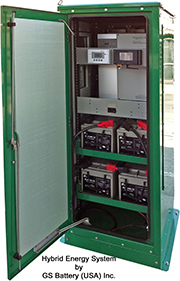 GS Battery (USA) Inc., (GSB) has deployed their Hybrid Energy System (HES). Equipped with 48 volts of ECO R advanced lead acid battery technology, the integrated, compact unit addresses the most common renewable energy storage needs in an easily installed, indoor/outdoor cabinet. Nine HES cabinets are in-service with three systems deployed by EPRI for the Tennessee Valley Authority SMART Station Program and six storage-only systems deployed as part of a complete EV charge station by Oak Ridge National Labs' US Department of Energy EV Charger trial program. GS Battery (USA) Inc., (GSB) has deployed their Hybrid Energy System (HES). Equipped with 48 volts of ECO R advanced lead acid battery technology, the integrated, compact unit addresses the most common renewable energy storage needs in an easily installed, indoor/outdoor cabinet. Nine HES cabinets are in-service with three systems deployed by EPRI for the Tennessee Valley Authority SMART Station Program and six storage-only systems deployed as part of a complete EV charge station by Oak Ridge National Labs' US Department of Energy EV Charger trial program.
The HES unit is capable of powering critical loads and has an optional integrated electric vehicle charger plug, level 2 EVSE. The option of combining battery storage with PV power generation gives the HES unit the expanded capability to operate either tied into the grid, as a stand-alone unit or in a hybrid mode. Rated NEMA 3R, the cabinet is built of outdoor grade aluminum and has an eco-green power coat finish. Additional options include an AC and a DC load centers, a PV charge controller, auxiliary heating and air conditioning, a hydrogen sensor and fan cooling.
"Customers are initially deploying the HES systems to store energy supplied by photovoltaic arrays and using this energy to charge electric vehicles," said Jeff Hires, engineering manager, GS Battery and the HES designer. "The option of Level 1 and Level 2 charging makes this system ideal for locations installing a stand alone charging station at an affordable cost. Plus, remote monitoring and control are built in making the system accessible anywhere over the internet."
"The advantages of the HES system, a true plug and play design, includes its versatility and its potential for future expansion as the user's needs evolve," commented Vince Pusateri, senior director of Business Development, GSB. "The initial use might be EV charging and as the user's needs change, the HES can be enhanced to include a UPS function, peak load shaving and even act as a stand-alone PV plus storage system for residential and small commercial use."
The HES system is unique in the market and is a cost effective solution for installers, integrators and distribution partners. The unit may be eligible for state and federal renewable energy or storage system rebates.
 ZMDI Releases a Smart Charger for Lithium-Ion Batteries ZMDI Releases a Smart Charger for Lithium-Ion Batteries
ZMD AG (ZMDI), a semiconductor company that specializes in enabling energy-efficient solutions has released the ZSPM4551, a DC/DC synchronous switching lithium-ion (Li-Ion) battery charger. As a global supplier of analog and mixed-signal solutions for automotive, industrial, medical, information technology and consumer applications, ZMDI focuses on developing families of compact and high-efficiency products including the ZSPM4551.
The ZSPM4551 is configurable for termination voltage, charge current and additional variables to allow optimum charging conditions for a wide range of Li-Ion batteries. Its 1 MHz switching frequency enables the use of small filter components, resulting in smaller board space and reduced system costs.
The ZSPM4551 has an integrated I2C interface, which enables the user to set application-specific temperature-compensated termination voltages and control charging currents. It can regulate up to 1.5 A continuous drive current.
The ZSPM4551 features integrated power switches, internal compensation and fault protection. It offers Li-ion-specific protection for over-current, over-temperature, battery (VBAT) over-voltage and charging timeout. It includes supervisory reporting through the NFLT (inverted fault) open-drain output for interfacing with other components in the system.
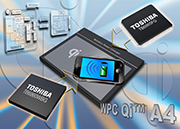 Toshiba Launches High-Current Output Chipset for Free Positioning Wireless Charging Toshiba Launches High-Current Output Chipset for Free Positioning Wireless Charging
Toshiba America Electronic Components, Inc. (TAEC) has released its free positioning wireless charging chipset consisting of a high-efficiency power transmitter and receiver for charging smartphones and other mobile products anywhere on the battery charging pad.
The Toshiba chipset is fully compliant with the Wireless Power Consortium (WPC) Qi interface specification, A4, A8, A12 and A14. It includes the TB6865FG power transmitter and TB6860WBG receiver and features a two-coil control architecture for cost-effective battery charging. The position of a mobile device is detected by the TB6865FG and only one of the coils is energized for charging, thereby preserving efficiency and allowing product freedom of placement. As a result, end users can place a Qi-capable mobile product on a Qi-compliant charging surface and achieve up to 74 percent efficiency across a majority of the charging area. In addition, the design flexibility of the TB6865FG allows the control of two coils, so two mobile products can be charged simultaneously.
Toshiba's chipset is built with the company's microcontroller and analog IC technology and features high levels of integration to reduce component count, board space and cost in wireless charging applications. The TB6865FG transmitter integrates both microcontroller and analog elements including PWM circuitry, switching control, on-board filter and a pre-driver circuit. The TB6860WBG receiver combines modulation and control circuitry with a rectifier power pickup, built-in high-performance DC-DC buck converter and protection functions.
The TB6860WBG offers a programmable charging profile via I2C control. The latter provides an integrated DC-DC converter for high-efficiency, high-current charging with a charge current of up to 1.2 A. Integrated protection for the receiver IC covers input voltage, output current and over-temperature conditions.
The TB6865FG is supplied in a LQFP100 1 4mm by 14 mm package while the TB6860WBG is supplied as a WCSP39 4.2b5mm by 2.65 mm device.
Toshiba has been a member of the WPC since it joined the consortium in 2011. In addition to wireless charging solutions built around inductive coupling, the company is also actively involved in research to develop commercial solutions that extend charging distances through the use of resonance coupling.
New AS8515 from ams Provides Integrated Solution for Automotive Battery Sensing
The AS8515 system-in-package (SiP) introduced by ams AG, a manufacturer of high-performance analog ICs and sensors for consumer, industrial and automotive applications, enables the implementation of a complete automotive battery measurement system when interfaced via SPI to any microcontroller.
The device is a stacked-die package consisting of a signal-processing die with two high-precision ADC channels for current, voltage and temperature measurements and a high-voltage CMOS die providing voltage regulation, a LIN transceiver and watchdog functions. Supporting manufacturers’ ISO26262 safety standard compliance processes, the device is well suited for battery management systems (BMS) for lithium-ion batteries in electric vehicles, hybrid electric vehicles and vehicles with an internal combustion engine.
Providing precise and linear 16-bit digital outputs, the AS8515 is well suited for implementing state of charge (SoC) monitoring in automotive batteries through measurement of open-circuit voltage and coulomb counting. The device also provides extremely accurate and linear conversion of small signals from other devices such as the pressure sensors used in a vehicle’s hydraulic, pneumatic or barometric systems.
By integrating voltage regulation and a LIN2.1 transceiver with signal-processing circuitry in a single package, the AS8515 provides a complete current and voltage measurement system that only requires the addition of a simple microcontroller and, for current measurement, a precision shunt resistor.
Offering two independent, high-resolution 16-bit ADC channels, it can measure signals from sub- micro volt up to 200 mV and measure current across a range from 1 mA to 2,000 A through a 100 micro Ohm shunt. All measurements are offset-free and highly linear across the device’s specified ambient temperature range (-40°C to 115°C). The two channels can be configured to measure the same input synchronously to provide a redundant design supporting functional safety.
|
| |
Industry News |
| |
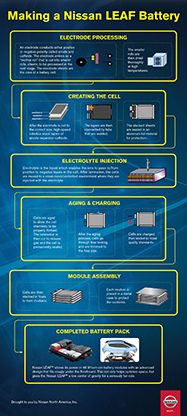 Nissan Celebrates Two Years of LEAF Sales with Announcement of US Battery Plant Nissan Celebrates Two Years of LEAF Sales with Announcement of US Battery Plant
With two years of Nissan LEAF sales just completed, the company has announced the launch of the United States' largest lithium-ion automotive battery plant in Smyrna, Tenn. The facility, which is making battery components for the ramp-up of production of the all-electric, zero-emission 2013 Nissan LEAF early next year, is one of three of its kind in the world operated by a major automaker.
Since December 2010, Nissan has delivered more than 18,000 LEAFs to US customers and more than 46,000 worldwide, making it the most successful 100-percent electric vehicle in history.
"Opening this U.S. plant is an important milestone in Nissan's overarching strategy to foster sustainable mobility around the world," said Carlos Ghosn, president and CEO of Nissan Motor Co. "Nissan is the zero-emissions vehicle leader, and we are making significant strides as one of the largest producers of electric vehicles and batteries in the United States. The opening of this facility in Tennessee supports our goal of making zero-emissions mobility a reality through American jobs and American manufacturing."
The first batteries produced at the plant have completed the required aging process and are now ready to receive their first charge. The state-of-the-art facility is capable of expanding to produce modules for up to 200,000 batteries annually depending on market demand. Those batteries can serve as the power source for the all-electric Nissan LEAF and for future vehicles that could be added to the portfolio.
The new battery plant is located adjacent to Nissan's existing vehicle assembly plant in Tennessee, which has been retooled to accommodate production of the Nissan LEAF. Adding production of the Nissan LEAF and the battery has resulted in the creation of more than 300 US manufacturing jobs to date. As battery production and LEAF assembly expand to accommodate demand, combined operations could add up to 1,000 additional jobs as needed.
The construction of the battery plant and modification of the Smyrna manufacturing facility represent an investment of up to $1.7 billion when built to full capacity. The project is supported by a US Department of Energy loan for up to $1.4 billion.
Thin-Film Batteries for Miniature Gadgets Set for Phenomenal Growth
Thin-film batteries hold the key to revolutionizing miniature devices. Their flexibility, small size and high power attributes position thin-film batteries as the go-to power source for the next-generation of power-hungry gadgets. New analysis from Frost & Sullivan’s Analysis of the Global Thin-film Battery Market research finds that the market earned revenues of $86.7 million in 2011 and estimates this to grow at an impressive rate to reach $1.99 billion in 2018.
“Thin-film batteries offer the flexibility to design a miniature gadget with a reliable power source,” said Frost & Sullivan Energy & Power Systems Industry Manager Suba Arunkumar. “The inherent tendency to be only a few millimeters thick and the flexibility to be designed in different shapes make thin-film batteries suitable for specific niche applications.”
Thin-film batteries are benefiting from the trend of many consumer electronic devices converging into a single, miniature, multi-functional, high-powered gadget. The market is also driven by the heightened need for small and light-weight security and surveillance devices.
This ability to adapt to a wide range of applications is fuelling market acceptance. Radio frequency identification device (RFID) tags, smart cards, sensors, and spy gadgets could use these batteries for powering their devices.
“Advancements in the manufacturing process of thin-film batteries will enhance their performance,” said Arunkumar. “This, in turn, will expand the base of end-user applications.”
Key challenges in this nascent market are the lack of standardization and limited number of manufacturers. Those that are active have a regional, rather than global, profile.
“Manufacturers need to compete in a common space, which could happen when all participants begin large-scale, high-volume commercial production,” said Arunkumar. “Mass commercial production will also be critical to bringing down the current high price of the technology.”
|
|
| |

|
 |
Event Listings |
 |
 |
 Battery Power 2013 Battery Power 2013
Battery Power 2013, an international conference highlighting the latest developments and technologies in the battery industry, will be held June 6-7 in Denver, Colorado. This 11th annual event will feature more than 35 presentations on portable, mobile and consumer battery technology, as well as battery manufacturing, materials and research & development, serving the consumer electronic, medical and military industries.
Topics will include new battery designs, emerging technologies, battery materials, power management, charging and testing systems, battery health, as well as the latest market trends affecting the industry. The conference is designed for OEM design engineers and system engineers involved in battery powered products and systems and power management technology, as well as battery pack and cell manufacturers.
Battery Power 2013 will provide you with the most up-to-date developments and technologies in the portable/mobile/consumer battery and power management market. If you are involved in the battery industry or if your products and systems run on batteries, this is a must attend event.
Call for Presentations
Battery Power 2013 is currently accepting abstracts. The international event will explore the important topics impacting battery power systems used in consumer electronics, medical and military markets. Topics will include design issues in battery cells and packs and emerging charging technologies to predicting battery failure and battery hybrid systems. Other topics include cell design and manufacturing, power management, testing, materials, market trends and end-user requirements for new applications.
The conference provides an excellent forum to discuss new developments in technology, market conditions and end-user requirements that are driving innovation, capabilities and features, application trends and performance improvements.
Attendees include top executives, technical managers and engineering professionals from battery pack and cell manufacturers, original equipment manufacturers, system developers and integrators, dealers and component providers.
Call for Presentations • Exhibitor Information
|
 |
 |
|
 |
 |
3rd Annual Electric Energy Storage Conference
January 8-10, 2013
The Embassy Suites Biltmore, Phoenix, AZ
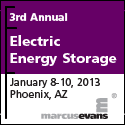 The 3rd Annual Electric Energy Storage Conference will be a two and a half-day, industry focused event, specific to those within EnergyStorage, Renewable Energy, Regulatory Policy and Planning and Research and Development. This conference will bring together the leading senior executives from PJM Interconnection, Luminant, NERC, MISO, Southern California Edison and many more to discuss technological advances and case studies, while focusing on the tools and strategies necessary to bring energy storage operations into real time energy operations. The 3rd Annual Electric Energy Storage Conference will be a two and a half-day, industry focused event, specific to those within EnergyStorage, Renewable Energy, Regulatory Policy and Planning and Research and Development. This conference will bring together the leading senior executives from PJM Interconnection, Luminant, NERC, MISO, Southern California Edison and many more to discuss technological advances and case studies, while focusing on the tools and strategies necessary to bring energy storage operations into real time energy operations.
 IWCE IWCE
March 11-15
Las Vegas, Nev.
IWCE Connects the Working World to Mobile Voice, Video and Data Solutions
IWCE, taking place March 11-15 (Exhibits: March 13-14), is the authoritative annual event for communications technology in the working world. Over 7,500 technology buyers from a diverse group of industry professionals from government, public safety, transportation, utilities and other enterprises gather together at IWCE to see the latest in effective and efficient wireless communications systems. The tradeshow features over 330 of the top manufacturers showcasing the latest in communications technology, and the conference program features an impressive lineup of the most influential industry leaders presenting on next-generation networks, spectrum utilization, emerging technologies, regulatory issues, smart cities, infrastructure and interoperability. More details can be found at www.iwceexpo.com.
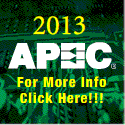 APEC 2013 APEC 2013
March 17-21
Long Beach, Calif.
As The Premier Event in Applied Power Electronics, APEC focuses on the practical and applied aspects of the power electronics business. This is not just a designer's conference; APEC has something of interest for anyone involved in power electronics:
-
Equipment OEMs that use power supplies and dc-dc converters in their equipment
-
Designers of power supplies, dc-dc converters, motor drives, uninterruptable power supplies, inverters and any other power electronic circuits, equipment and systems
-
Manufacturers and suppliers of components and assemblies used in power electronics
-
Manufacturing, quality and test engineers involved with power electronics equipment
-
Marketing, sales and anyone involved in the business of power electronics
-
Compliance engineers testing and qualifying power electronics equipment or equipment that uses power
|
 |
| |
Contact Us |
|
| |
Submit editorial content to Shannon Given at 608-351-9245
For advertising information contact Jeremy Fleming at 800-803-9488 X121
Webcom Communications • 7355 E. Orchard Road, Suite 100; Greenwood Village, CO 80111
Phone: 800-803-9488 • Fax: 720-528-3771 • www.infowebcom.com |
|
| |
© 2012 Webcom Communications Corp. |
|
|
|
|
|
|